There’s a veritable alphabet soup of tire ratings out there, making it feel like you need to decode hieroglyphics just to understand what’s on your wheels. Tire jargon is a whole language in and of itself. But fear not, dear reader. In this guide, I’ll serve as your tire translator and tell you exactly what those 112t, 112s, 112q, 112h, 112r, 112v, 112w designations mean. So let’s roll!
What Do 112t, 112s, 112q, 112h, 112r, 112v, 112w Mean on a Tire?
These mystifying numbers and letters are the tire load and speed rating. The ‘112’ represents the tire’s maximum load carrying capacity, while the letter (t, s, q, h, r, v, w) signifies the maximum speed the tire can safely maintain. Let’s take a closer look at each of these speed ratings.
Visualizing the Information
| Load Index (112) | Speed Symbol | Speed Rating (km/h) |
|---|---|---|
| 112 | T | 190 |
| 112 | S | 180 |
| 112 | Q | 160 |
| 112 | H | 210 |
| 112 | R | 170 |
| 112 | V | 240 |
| 112 | W | 270 |
Each speed rating is set by the tire manufacturer, ensuring that your tires are not pushed beyond their intended capabilities, as that can be as dangerous as letting a toddler commandeer a bulldozer.
What Does 112T Mean on a Tire?
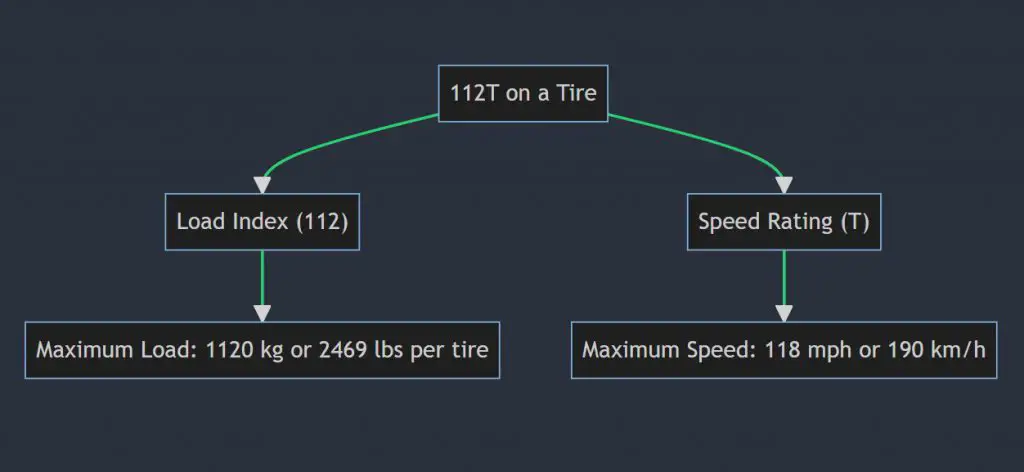
Imagine you’re cruising down the highway. The sun is out, the wind in your hair, and ‘112T’ on your tires. What does it mean? Let’s break it down:
- Load Index: The ‘112’ is the load index. This number represents the maximum weight the tire can safely carry. For a tire with a load index of 112, that’s up to 1120 kilograms or 2469 pounds per tire. That’s about the weight of an average hippopotamus! So if you ever need to transport a hippo, make sure your tires are up to the task.
- Speed Rating: The ‘T’ stands for the speed rating. A 112T rated tire can safely maintain speeds up to 190 km/h (118 mph). That’s not exactly Formula 1 speeds, but unless you’re racing against Lewis Hamilton, it should be plenty fast enough.
So the next time you see ‘112T’ on your tire, just remember it’s the hippo transporter who isn’t quite ready for the Grand Prix.
What Does 112S Mean on a Tire?
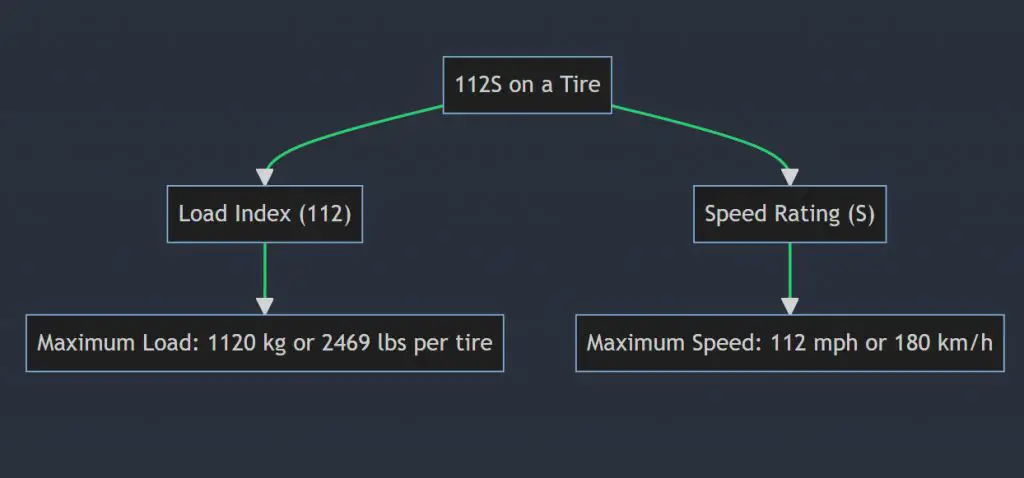
Time to decode another tire enigma: the 112S. Is it the sequel to a spy movie? A robot model? No, it’s another load and speed rating.
- Load Index: The ‘112’ again stands for the tire’s load-carrying capacity. It can safely carry 1120 kg or 2469 pounds per tire – that’s the weight of about 12 grand pianos. A symphony’s worth, all on one tire.
- Speed Rating: The ‘S’ is the speed rating, denoting a maximum speed of 180 km/h (112 mph). So while it might not get you to a concert on time if it’s halfway across the country, it’s still a pretty respectable speed.
As for your tire’s symphony, it plays best at a brisk tempo, but not too allegro. The 112S tire ensures your road trip stays more Mozart than Metallica.
What Does 112Q Mean on a Tire?
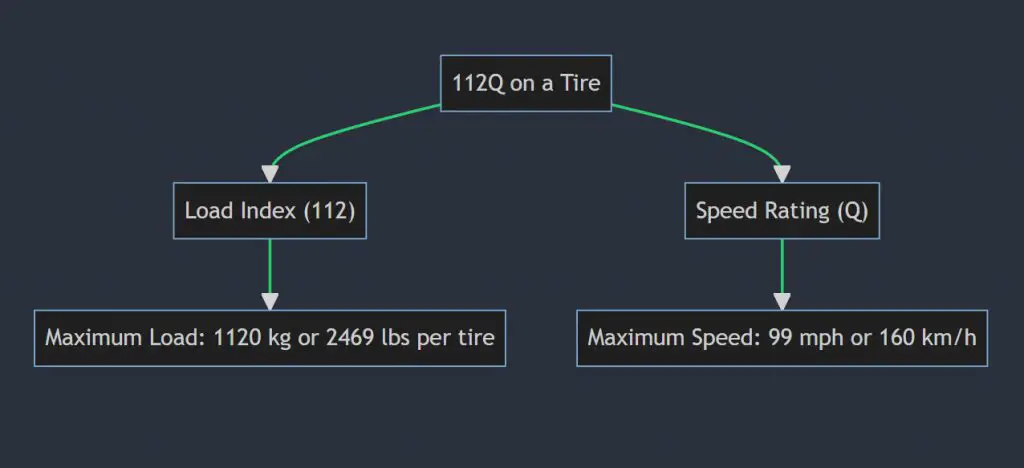
Alright folks, buckle up. We’re diving into another tire rating: 112Q. Now, this might sound like a lost piece from a game of Scrabble, but trust me, it’s crucial when it comes to your tire’s safety and performance.
- Load Index: You guessed it. That ‘112’ is the tire’s load index, which means this tire can safely support a load of up to 1120 kg or 2469 lbs per tire. That’s approximately the weight of a small rescue boat. So while I wouldn’t recommend trying to float your car across a body of water, it’s comforting to know your tire could handle a boatload of weight.
- Speed Rating: The ‘Q’ stands for the tire’s speed rating. A 112Q rated tire is rated to go up to 160 km/h or 99 mph. That’s not quite autobahn speeds, but it’s certainly fast enough to get you to your destination in time for the big game, or perhaps a Scrabble match.
In summary, ‘112Q’ is the workhorse of tire ratings. It’s the tire equivalent of that trusty old family pet: loyal, reliable, and can comfortably carry a small boat without breaking a sweat.
What Does 112H Mean on a Tire?
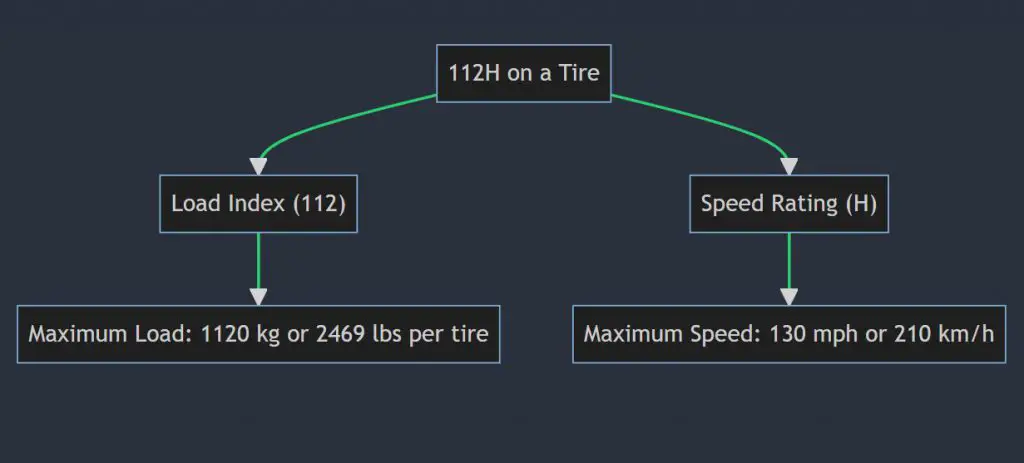
Switching gears (pun very much intended), we have the 112H tire rating. Does this mean it’s a tire destined for H-towns like Houston or Honolulu? Not quite. But let’s dissect this tire rating:
- Load Index: The ‘112’ represents the tire’s load index. This tire can support up to 1120 kg or 2469 lbs per tire. That’s about as heavy as a fully grown male bison. Just in case you were planning on transporting one in your sedan.
- Speed Rating: The ‘H’ stands for the tire’s speed rating. An ‘H’ rated tire can safely handle speeds up to 210 km/h (130 mph). That’s a speed at which you could outrun a cheetah (although I wouldn’t recommend trying).
So, if you see ‘112H’ on your tire, just think of it as your reliable, bison-carrying, cheetah-outpacing companion. Perfect for your everyday driving or those spontaneous cross-country road trips.
What Does 112R Mean on a Tire?
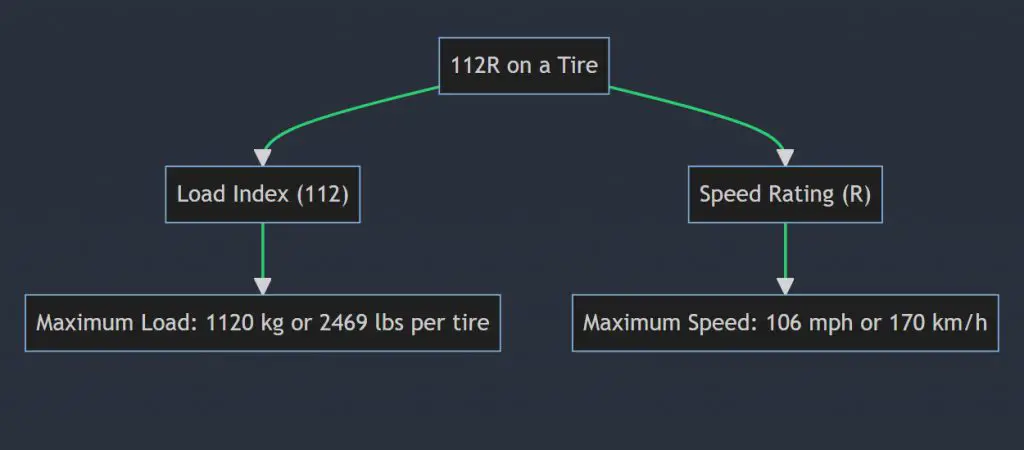
Lastly, let’s crack the code of the elusive 112R tire rating. Does the ‘R’ stand for Radical? Racing? Ridiculously good at its job? Well, let’s find out:
- Load Index: Again, that ‘112’ is the tire’s load index, meaning it can safely support a weight of up to 1120 kg or 2469 lbs per tire. In other words, this tire can carry the equivalent weight of a small car… on each tire. Talk about carrying your own weight!
- Speed Rating: The ‘R’ is the speed rating, denoting a maximum speed of 170 km/h or 106 mph. Now that’s not Formula 1 speeds, but it’s still quite zippy. Fast enough to give a greyhound a run for its money.
So in essence, ‘112R’ tires are your reliable, small-car-carrying, greyhound-racing sidekicks, ready to take on the open road at a moment’s notice.
What Does 112V Mean on a Tire?
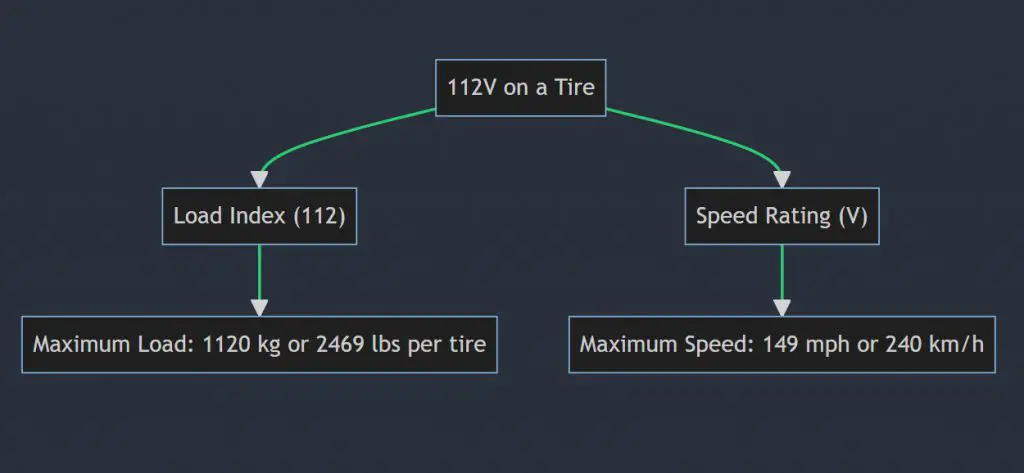
Batten down the hatches, folks, because we’re about to venture into the land of 112V tire rating. If you’re picturing an exciting action movie title right now, I can’t blame you. But let’s unravel this tire mystery:
- Load Index: The ‘112’ portion is the load index, signifying the tire can handle a weight of up to 1120 kg or 2469 lbs per tire. That’s the equivalent weight of a small giraffe. Ever wanted a safari on wheels? Now’s your chance!
- Speed Rating: The ‘V’ represents the speed rating, which means the tire can safely maintain speeds of up to 240 km/h (149 mph). That’s faster than the top speed of a peregrine falcon – the fastest animal on earth.
So when you spot a ‘112V’ on your tire, just imagine it as your personal road-going giraffe that can outpace a falcon. Now isn’t that a mental image to enjoy on your next drive?
What Does 112W Mean on a Tire?
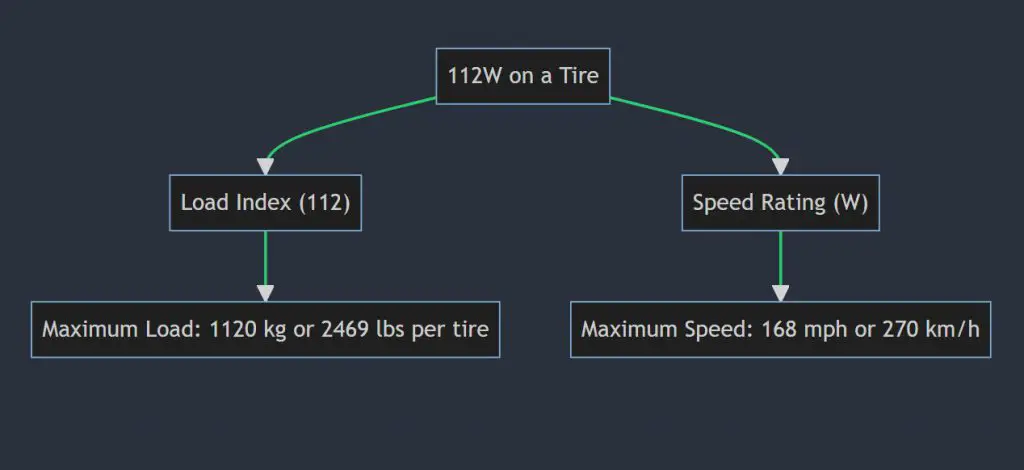
Ladies and gentlemen, we have arrived at our final destination: the 112W tire rating. So, what does this mean? Is it the tire version of a worldwide wrestling match? Well, not exactly, but let’s break it down:
- Load Index: The ‘112’ represents the tire’s load index, which means it can safely support a load of up to 1120 kg or 2469 lbs per tire. It could carry about 1300 bowling balls! Next time you’re planning a bowling tournament on the go, you know which tires to get.
- Speed Rating: The ‘W’ stands for the tire’s speed rating. A 112W rated tire is designed to maintain speeds of up to 270 km/h (168 mph). That’s just about as fast as a cheetah riding a rocket. I know, it’s hard to picture, but isn’t it fun trying?
Therefore, a tire with the ‘112W’ rating is the tire equivalent of a bowling alley on wheels that can also potentially keep up with a rocket-propelled cheetah. This tire is not messing around.
FAQs
Now let’s dive into some common queries to help deepen your understanding of tire ratings.
1. What does 115/112Q mean on a tire?
The numbers before the slash (115/112Q) represent the load index for single and dual applications (if it’s a commercial vehicle tire), respectively. The letter ‘Q’ is the speed rating.
2. 112T vs 112S: Which is better?
Neither is “better,” they simply have different maximum speeds. 112T rated tires can handle up to 118 mph, while 112S tires are safe up to 112 mph.
3. 112T vs 116T: What’s the difference?
The key difference is the load capacity. A 112T tire can handle 1120 kg, while a 116T tire can carry 1250 kg. More weight, more party, right?
4. 112T vs 115T tire: What’s the difference?
It’s all about weight capacity. 112T tires can carry 1120 kg, but 115T tires can bear 1215 kg. Because sometimes you need to transport an extra grand piano.
5. 112T vs 112H: Which is faster?
112H wins the speed contest. While 112T tires can handle up to 118 mph, 112H tires leave them in the dust at 130 mph.
6. 112T vs 121S: What’s the difference?
The ‘121’ in 121S means it can carry a higher load (1450 kg) compared to 112T (1120 kg). So, if you’re carrying a small elephant, go for 121S.
7. 112T vs 113T: What’s the difference?
113T can carry slightly more weight than 112T (1150 kg vs 1120 kg). Remember, every kilogram counts, especially when you’re planning a road trip.
8. 112Q vs 123Q: Which is stronger?
The ‘123’ in 123Q denotes a higher load index, meaning it can carry more weight than the 112Q. In fact, it can carry up to 1550 kg. It’s like comparing a heavyweight to a middleweight boxer.
9. what is load index 112 on a tire?
The load index of a tire represents the maximum weight that each tire can safely carry when properly inflated. This value is usually printed on the sidewall of the tire, along with other important information like speed rating and tire dimensions. A load index of 112 indicates that the tire can carry up to 2,469 pounds (or approximately 1,120 kilograms).
It’s important to ensure that the load index of the tires you choose meets or exceeds the requirements for your vehicle. You can usually find this information in your vehicle’s owner’s manual or on a sticker located on the driver’s side door jamb.
Recap And Summary
We’ve been on a wild ride, haven’t we? From sprinting cheetahs to orchestras, rocket-propelled wildlife to bouncing bowling balls, we’ve navigated the sometimes baffling world of tire ratings.
Here’s a quick recap:
- The number (112 in our examples) is the Load Index. This value tells us how much weight the tire can safely carry. Our friendly neighborhood tire can hold up to 1120 kg, or the weight of a small rescue boat, a bison, a small giraffe, or even a stack of 1300 bowling balls!
- The letter that follows is the Speed Rating, which tells us the maximum speed the tire is designed to handle. In our journey, we’ve covered tires that can rival cheetahs (112H, 112W), greyhounds (112R), and even the fastest bird, the peregrine falcon (112V).
So, each tire rating is a specific recipe, a unique blend of strength (Load Index) and speed (Speed Rating). But remember, these tire ratings aren’t just for fun. They’re crucial markers of safety.
Alternative Tire Size Codes of Similar Specifications

AR Jeet has been a tire mechanic for over 2years. He has worked on all types of vehicles, from cars and trucks to RVs and ATVs and motorcycles. He has seen it all when it comes to tires, and he knows how to fix them.
AR Jeet is a tire expert, and he is passionate about his work. He loves to help people keep their vehicles running smoothly, and he is always happy to answer any questions that people have about their tires.
If you need help with your tires, or if you just want to learn more about them, then AR Jeet is the man to talk to. He will be happy to help you out, and he will make sure that you get the best possible solution.
He has a blog [Tirespick.com] where he writes about all things tire-related, and he is always happy to help people with their tire needs. Know more about AR Jeet.
